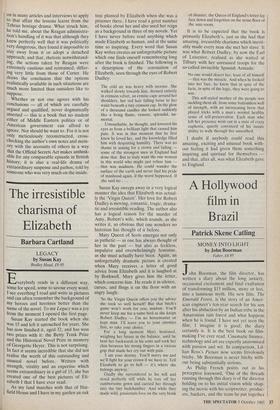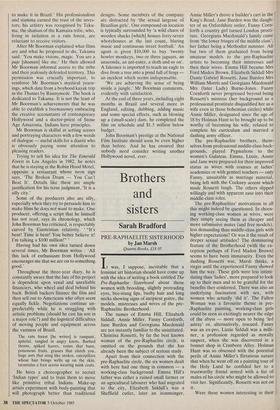A Hollywood film in Brazil
Patrick Skene Catling
MONEY INTO LIGHT by John Boorman
Faber, £4.95
John Boorman, the film director, has written a diary about the long anxiety, occasional excitement and final exultation of transforming $15 million, more or less, into a luminous myth. His new film, The Emerald Forest, is the story of an Amer- ican engineer's ten-year search for his son after his abduction by an Indian tribe in the Amazonian rain forest and what happens when he is found. I have not yet seen the film; I imagine it is good; the diary certainly is. It is the best book on film- making I've ever read. Cinematic finance, technology and art are expertly anatomised with passion and wit. In comparison, Lil- lian Ross's Picture now seems frivolously bitchy. Mr Boorman is never bitchy with- out being substantially serious.
As Philip French points out in his perceptive foreword, One of the threads running through this diary is of the director holding on to his initial vision while shap- ing the movie with his scriptwriter, produc- ers, backers, and the team he put together to make it in Brazil.' His professionalism and stamina earned the trust of the inves- tors; his artistry was recognised by Taku- ma, the shaman of the Kamaira tribe, who, living in isolation in a rain forest, are reluctant to receive visitors.
After Mr Boorman explained what films are and what he proposed to do, Takuma said: 'You make visions, magic. You are a paje [shaman] like me.' He then allowed Mr Boorman informal access to the tribe and their jealously defended territory. This permission was crucially important, to reinforce Mr Boorman's mystical yearn- ings, which date from a boyhood kayak trip in the Thames by Runnymede. The book is dedicated to Takuma. It is not the least of Mr Boorman's achievements that he was able to establish a freemasonry embracing the creative accountants of contemporary Hollywood and a doctor-priest of Stone Age Amazonia. Indians have principles.
Mr Boorman is skilful at setting scenes and portraying characters with a few words of dialogue — useful skills for a diarist who is obviously paying some attention to pleasing readers.
Trying to sell his idea for The Emerald Forest in Los Angeles in 1982, he notes that he is staying at the Robin Hood Motel, opposite a restaurant whose neon sign says, 'The Broken Drum — You Can't Beat It'. Details like these are ample justification for his terse judgment, 'It is a silly city.'
Some of the producers also are silly, especially when they try to persuade him to make films he does not want to make. One producer, offering a script that he himself has not read, says its chronology, which John Boorman has criticised, is respectably curved by Einsteinian relativity. "It's bent! Time is bent! You better believe it! I'm talking a $100 million!" ' Having had his own idea turned down several times, Mr Boorman writes : All this lack of enthusiasm from Hollywood encourages me that we are on to something good.'
Throughout the three-year diary, he is constantly aware that the fate of his project is dependent upon venal and unreliable financiers, who wheel and deal behind his back. British backers finance the film and then sell out to Americans who often seem equally fickle. Negotiations continue un- predictably while he is struggling with artistic problems (should he cast his son in a major role?) and the logistical difficulties of moving people and equipment across the vastness of Brazil.
The rain forest he writes] is rampant, spiteful, tangled in angry knots. Barbed thorns, spiked leaves, resins that burn, poisonous fruits, grasses that clutch you, huge ants that sting like snakes, caterpillars whose hair brings welts up on the skin, tarantulas a foot across wearing mink coats.
He hires a choreographer to recruit 'Indian types' and to train them to move like primitive tribal Indians. Make-up artists experiment with body-painting that will photograph better than traditional designs. Some members of the company are distracted by 'the sexual largesse of Brazilian girls'. One compound on location is typically surrounded by `a wild chaos of wooden shacks [which] houses forty-seven whorehouses at the last count, blaring music and continuous street football.' An agent is given $10,000 to buy 'twenty howler monkeys, two or three jaguars, an anaconda, an ant-eater, a sloth and so on'. A falconer is imported to teach an eagle to dive from a tree into a pond full of frogs an incident which seems indispensable.
'We are achieving the sense of being inside a jungle,' Mr Boorman comments, evidently with satisfaction.
At the end of three years, including eight months in Brazil and several more in England, editing, dubbing, adding music and some special effects, such as blowing up a (small-scale) dam, he completed the film on schedule and $1.5 million below budget.
John Boorman's prestige at the National Film Institute should soon be even higher than before. And he has ensured that nobody need consider writing another Hollywood novel, ever.



























































 Previous page
Previous page